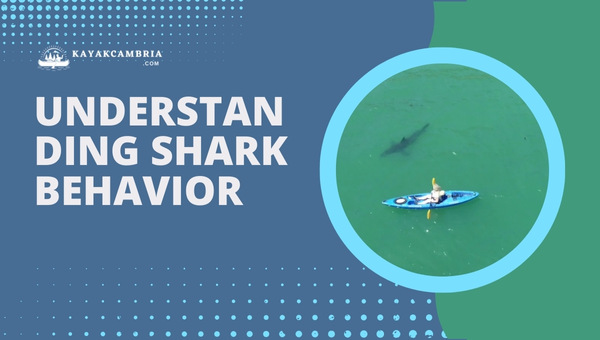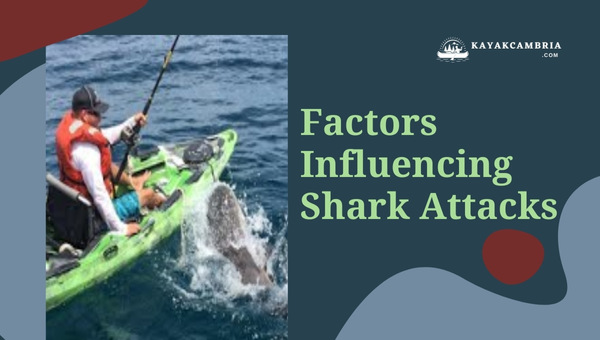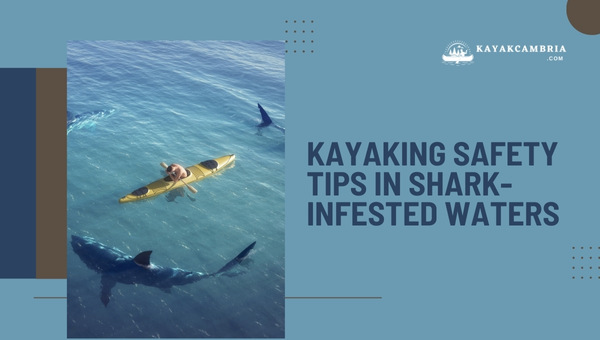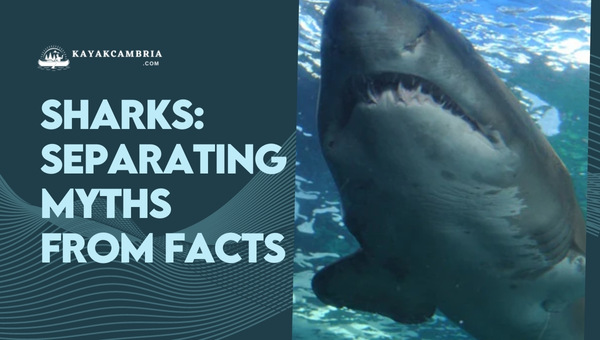As a kayaking enthusiast, I can’t help but wonder, do sharks attack kayaks? It’s a common question that many paddlers have on their minds, especially when kayaking in shark-infested waters. While it’s true that sharks are magnificent predators and can be quite curious, the likelihood of them attacking a kayak is relatively low.
When we consider the factors that can potentially provoke a shark, it becomes apparent that the colorful, small, and relatively non-threatening appearance of kayaks doesn’t fit the bill for their typical prey.
Sharks generally aren’t interested in attacking objects on the water’s surface, as it’s not where they usually find their food. In fact, some researchers believe that the rare instances in which sharks have “attacked” kayaks might actually be cases of mistaken identity, collisions, or curiosity rather than aggression.
With that said, it’s essential to take precautionary measures while kayaking in areas known for sharks. Avoid paddling close to schools of fish, seals, or other creatures that may attract them.
Also, try to stay visible by wearing brightly-colored gear and keeping a safe distance from any sharks you may encounter. Ultimately, the chances of a shark attacking a kayak are slim, so don’t let the fear of these amazing animals deter you from enjoying the serenity of the open waters.
Contents
Contents
Understanding Shark Behavior
To help explain whether or not sharks attack kayaks, it’s crucial to first delve into shark behavior. By gaining insights into these magnificent creatures, we can better comprehend their actions and mitigate potential risks when exploring their natural habitats.

Sharks are known for their remarkable senses that make them efficient hunters. Primarily, they rely on their sense of smell, electroreception, and lateral line system, which allows them to detect vibrations in the water. When they sense prey or any unfamiliar object nearby, they often approach it out of curiosity.
Curiosity, contrary to popular belief, is a significant factor in shark-human interactions. While movies and the media often portray them as terrifying creatures lurking in the depths, seeking their next meal, their interactions with humans tend to be more exploratory rather than aggressive. It’s important to note that the likelihood of a shark attack is minimal in comparison to other risks encountered in daily life.
That being said, there have been reported cases of sharks displaying curious behavior towards kayaks. But it’s essential to differentiate between curiosity and aggression. Here are some shark behaviors to keep in mind:
- Bumps: A shark may occasionally bump into a kayak to investigate an unfamiliar object. This action is typically non-aggressive and should not be considered as an imminent attack.
- Bites: In very rare cases, sharks might bite a kayak, likely a case of mistaken identity where they mistake the kayak for its natural prey. Most of these incidents don’t result in severe injuries to the kayaker.
Considering these behaviors, it’s clear that sharks don’t naturally attack kayaks. When it comes to “Do sharks attack kayaks”, the answer is that these occurrences are infrequent and usually due to curiosity or mistaken identity. It’s important to remember that the ocean is their home, and we should take necessary precautions when sharing their environment.
To further reduce the likelihood of a shark approaching your kayak, consider the following measures:
- Avoid wearing brightly colored clothing or gear, as this can attract their attention.
- Stay close to shore and avoid paddling in deep waters or known shark habitats.
- Keep away from seals and schools of fish, as these are typical prey for many shark species.
- Ensure kayak equipment is secured, and food items aren’t left open to avoid emitting smells that may attract sharks.
By understanding shark behavior and taking necessary precautions, we can greatly minimize the risks associated with kayaking in their habitats. So, while the fear of a shark attack on a kayak might be lingering in our minds, the reality is that it’s an uncommon event and not something to stop us from enjoying the ocean.
Factors Influencing Shark Attacks
When it comes to the question, “Do sharks attack kayaks?”, there are several factors that can influence shark attacks on kayakers. Understanding these factors can help to alleviate concerns and allow for a more enjoyable experience on the water.

Environmental factors play a significant role in the likelihood of sharks attacking kayaks. Some of the key environmental factors include:
- Water temperature: Sharks are typically more active in warmer waters.
- Presence of prey: If an area has a high concentration of the shark’s natural prey, such as seals or schools of fish, the chances of an encounter increase.
- Time of day: Dusk and dawn are prime feeding times for many sharks, making these times of day potentially riskier for kayakers.
Kayak design and activity can also impact the chances of a shark attack. Some factors to consider are:
- Kayak color: A brightly colored kayak might be less likely to be mistaken for a shark’s natural prey, reducing the chances of an attack.
- Splashing and noise: Excessive noise and splashing can draw a shark’s attention, increasing the likelihood of an encounter.
- Fishing: Fishing from a kayak introduces the scent of bait and the struggle of caught fish, which can potentially attract sharks.
Lastly, it’s important to consider the behavior of the kayaker during their time on the water. Taking precautions and being aware of one’s surroundings can contribute to a safer experience. Some good practices include:
- Staying in groups: Kayaking in groups can deter sharks, as they generally prefer to target a single, isolated prey.
- Avoiding areas of known shark activity: Steering clear of areas with a high concentration of sharks can reduce the likelihood of an encounter.
- Paying attention to wildlife behavior: If birds are diving into the water to feed or seals are actively hunting, it can be a sign that sharks may be in the same area.
It’s important to remember that while shark attacks on kayaks do occur, they are relatively rare. The risk can often be managed by being aware of the factors that influence shark attacks and taking appropriate precautions.
Do Sharks Mistake Kayaks For Prey?
It’s a question many adventure-seekers may ask themselves: do sharks attack kayaks, and if so, why? The answer can be nuanced, so let’s dive into the specifics.

Firstly, sharks are curious creatures and may sometimes approach or bump into kayaks while investigating their surroundings. This isn’t a deliberate attack, but rather the shark’s way of understanding its environment. When this happens, it’s crucial for kayakers to remain calm and avoid making sudden movements.
Now, let’s address the possibility of sharks mistaking kayaks for prey. There is some anecdotal evidence suggesting that, in rare instances, sharks may see a kayak and confuse it with a possible meal. This can be partly attributed to the kayak’s silhouette, as it resembles that of a seal or sea lion.
It’s essential to remember that sharks rely on their senses to hunt for food, and they have been known to employ a method called bump and bite in order to test if an object is worth eating. As a result, a shark may investigate a kayak by biting it, but such occurrences are extremely rare.
To better visualize the situation, consider these key points:
- Kayaks account for a very small percentage of shark encounters.
- Sharks are generally uninterested in kayaks and are more focused on their natural prey.
- It’s critical for kayakers to avoid areas with known shark activity, especially during feeding times (dawn and dusk).
Shark attack statistics further support the conclusion that kayak encounters are minimal. According to the International Shark Attack File (ISAF), from 2011 to 2020, there were only 20 reported incidents involving kayaks, with no fatalities. To put that into context, here’s an overview of shark attack data from the same time period:
| Incident Type | Number of Incidents | Fatalities |
| All activities | 663 | 96 |
| Kayak-related | 20 | 0 |
While it’s possible that sharks could mistake kayaks for prey, such cases are exceedingly uncommon. Proper precautions, like staying close to shore and avoiding known shark hotspots, can help reduce the likelihood of encountering a shark during your kayaking adventure.
Recorded Kayak-Shark Encounters
I’ve researched documented kayak-shark encounters to provide a clear understanding of whether sharks attack kayaks or not. It’s important to recognize that sharks are often curious by nature, and most incidents are considered non-aggressive or investigatory in nature.

Over the years, there have been a few notable kayak-shark encounters that caught the attention of the media. While do sharks attack kayaks remains a question of interest, I have found some key instances:
- In 2017, a 3.5-meter great white shark was filmed attacking a kayak in Monterey Bay, California. However, no injuries were reported, and the kayaker was rescued by a nearby sailboat. The shark seemed more curious than aggressive.
- In 2015, a man was kayaking off the coast of Massachusetts when a great white shark bit his kayak’s bow. The kayak capsized, but the man swam back to shore without any injury.
- In 2014, a woman fishing from a kayak in South Africa was bumped by a great white shark. The shark did not attempt to bite the kayak, and the woman safely returned to shore.
To put these encounters in context, here are some relevant data points:
| Year | Number of Recorded Shark Attacks on Kayaks |
| 2020 | 2 |
| 2019 | 1 |
| 2018 | 4 |
| 2017 | 6 |
These numbers suggest that shark attacks on kayaks are relatively rare occurrences. Consider the following:
- A majority of shark encounters with kayaks appear to be non-aggressive and more exploratory in nature.
- The number of recorded shark attacks on kayaks remains significantly low when compared to other water-based activities, such as swimming or surfing.
To further understand the risks involved, let’s consider some facts about shark behavior:
- Curiosity: Sharks may show interest in anything out-of-the-ordinary in their environment, which may include kayaks.
- Mistaken Identity: In some cases, sharks might mistake kayaks for prey, like seals or sea turtles, leading to investigatory bites.
- Feeding Grounds: Kayakers who venture into known shark feeding areas may increase the likelihood of an encounter.
While the possibility of sharks attacking kayaks is real, the likelihood of such an event happening is relatively low. By following safety guidelines and being aware of one’s surroundings, kayakers can minimize their risks while enjoying the open waters.
How To Minimize The Risk Of A Shark Attack
When I’m out on my kayak, one thought that occasionally crosses my mind is, “Do sharks attack kayaks?” Although such incidents are rare, they can happen. Despite their infrequent occurrence, it’s always smart to take precautions and minimize the risk.

Here’s a list of measures I suggest taking before and during your kayaking trips to reduce the chances of a shark encounter:
- Choose your location wisely: Opt for areas with low shark activity. Research the area before you embark on your adventure, and ask local kayak rental shops or other kayakers for their insight.
- Buddy up: Kayaking with a friend or in a group offers an added layer of protection. Sharks are less likely to approach a larger flotilla of kayaks than a solo vessel.
- Be aware of your surroundings: Keep an eye out for signs of nearby sharks, such as dorsal fins, splashing, or baitfish. Engaging in other activities, like fishing, can also attract sharks.
- Avoid low visibility situations: Staying away from murky water minimizes the risk of a mistaken identity situation where a shark might confuse your kayak for prey. Stick to clear water when paddling.
- Steer clear of shark-feeding times: Sharks are known to hunt around dawn, dusk, and nighttime, so plan your kayaking trip during daylight hours.
- Wear appropriate attire: Brightly colored clothing or kayaks can attract sharks’ attention. Stick to more subdued and neutral tones.
- Avoid wearing jewelry: Sharks can be drawn to the glint of metal, so it’s best not to wear anything shiny.
To summarize, paddling out into open water carries its own set of risks, and shark encounters are part of that reality. By taking these simple steps, you can reduce the likelihood of a shark encounter and enjoy your kayaking adventure without as much worry:
- Do your research and choose an area with a low history of encounters
- Kayak with friends or in a group
- Keep an eye on your surroundings and avoid anything that might attract a shark
- Stick to clear water and daylight hours
- Dress smartly and leave the shiny pieces at home
By staying vigilant and taking these precautions, you’re well on your way to ensuring a safer and more enjoyable kayaking experience.
Kayaking Safety Tips In Shark-Infested Waters
When I’m out kayaking, one question that often crosses my mind is, do sharks attack kayaks? Although such encounters are rare, these magnificent predators have been known to come into contact with kayaks on occasion. That’s why it’s essential to follow proper precautions when paddling in shark-infested waters. Here are some kayaking safety tips to keep in mind:

1. Choose the right location
Not all waters are shark territory, and selecting an area with fewer sightings is an excellent way to minimize risks. Some regions have lower shark populations, so research your intended destination before pushing off.
2. Avoid wearing bright colors
Sharks are attracted to strong contrasts, and brightly colored clothing can make you more visible to these incredible creatures. Stick to more muted tones to blend in with the water and avoid drawing inquisitive sharks.
3. Paddle in groups
Sharks are less likely to approach if there are multiple vessels around. Traveling with a group of kayakers not only reduces the likelihood of a shark attack but also enables you to assist each other in the event of an emergency.
4. Be aware of your surroundings
It’s crucial to stay vigilant and pay attention to any changes in the marine environment. Here are some signs that may indicate the presence of sharks:
- Agitated fish, darting to the surface
- Diving birds, scooping up fish
- Seals swimming closer to shore
5. Avoid dawn and dusk
Sharks are most active during these times, making it riskier to paddle at the early hours of the morning or late afternoon. Kayaking during daylight will give you better visibility and decrease your chances of encountering sharks.
6. Stay away from fishing lines
If you see fishing activities nearby, be sure to keep a safe distance. Sharks may be attracted to the bait or the caught fish, increasing the likelihood of close encounters.
7. Use caution when returning to shore
In the event of a nearby shark sighting while you’re already on the water, it’s essential to calmly and smoothly return to shore. Avoid splashing, as this may entice a curious shark.
8. Remember, sharks are not the enemy
Sharks often get a bad rap, but they are an essential part of the ocean ecosystem. While it’s essential to take measures to protect yourself while kayaking, it’s important to respect these fascinating creatures and do our part to conserve their habitats.
By keeping in mind these essential kayaking safety tips, I can confidently tackle shark-infested waters while minimizing my chances of a close encounter with these powerful predators.
Species Of Sharks and Their Threat Levels

When discussing the potential threat of sharks to kayakers, do sharks attack kayaks, selecting a few key species of sharks to focus on may provide valuable insight. Among the hundreds of shark species, only a handful are responsible for human incidents or potential encounters with kayaks.
1. Great White Shark

The Great White Shark is arguably one of the most dangerous shark species. With their large size (up to 20 feet long) and powerful bite force, great whites are known to occasionally attack watercraft and kayakers.
Threat Level: High
2. Bull Shark

Bull Sharks are another species well-known for their unpredictable behavior and human incidents. These opportunistic predators can be found in shallow coastal waters, making them more likely to encounter kayakers.
Threat Level: High
3. Tiger Shark

The Tiger Shark is infamous for its appetite for various prey, from dolphins to turtles and even trash. While they usually avoid encounters with humans and kayaks, their curiosity and hunting behavior make them a potential threat.
Threat Level: Moderate
4. Hammerhead Shark

Hammerhead Sharks are one of the more easily identifiable species of sharks, with their unique head shape. They’re generally not considered dangerous to humans or kayakers, though they may be curious about unidentified floating objects, including kayaks.
Threat Level: Low
5. Nurse Shark

Nurse Sharks are relatively docile sharks that tend to ignore humans and watercraft. With their preference for crustaceans and slow-moving behavior, it’s highly unlikely for them to target a kayak.
Threat Level: Very Low
To summarize, the possible threat levels of these species to kayaks are:
| Shark Species | Threat Level |
| Great White | High |
| Bull Shark | High |
| Tiger Shark | Moderate |
| Hammerhead Shark | Low |
| Nurse Shark | Very Low |
When considering the question “Do sharks attack kayaks,” it’s essential to keep in mind the rarity of such events. Sharks are fascinating creatures that don’t pose a significant threat to kayakers, and while some species may be more curious or unpredictable than others, it’s essential to remember that these powerful predators typically have little interest in human vessels.
Sharks: Separating Myths from Facts
When it comes to the topic of whether or not sharks attack kayaks, there’s a lot of speculation and fear instilled by media portrayals and popular culture. Let’s dive into the real story and separate the myths from the facts.

First and foremost, I’d like to point out that sharks aren’t the mindless killers they’re often portrayed to be. In fact, these incredible creatures play an essential role in maintaining balance within the marine ecosystem. Now, let’s talk about the risks posed to kayakers.
While it’s true that incidents involving sharks and kayaks have occurred, they are incredibly rare. Shark attacks on humans in general are quite uncommon, with the International Shark Attack File reporting 129 shark-related incidents worldwide in 2020, out of which only 57 were unprovoked. To put that into perspective, consider the following:
- The average odds of getting struck by lightning is about 1 in 3,000.
- Records show more than 3,534 drownings occurred in the U.S. in 2019.
These figures demonstrate that encountering sharks while kayaking should not be your primary concern when venturing into the open water.
It’s essential to keep in mind that most shark species aren’t even inclined to attack humans. Out of the more than 400 different shark species, just a few are known to pose a potential threat, such as the great white, bull, and tiger shark. The vast majority of shark species are either too small, too timid, or focused on their typical prey to show any interest in humans.
To further decrease the likelihood of a shark encounter while kayaking, consider following these safety tips:
- Avoid paddling during the early morning and late afternoon hours when sharks are most active.
- Steer clear of seal colonies, as they are a primary food source for large sharks.
- Refrain from wearing shiny or bright-colored clothing that may attract a shark’s attention.
The fear of sharks attacking kayaks is mostly based on misconceptions and unfounded myths. While it’s important to respect these ancient predators and take necessary precautions, you should feel confident in your safety while paddling across the open waters. Being aware of the facts and applying proper safety measures will help ensure that your kayaking experience remains uneventful and enjoyable.
Conclusion: Are Kayakers Safe from Sharks?
So, do sharks attack kayaks? While incidences of shark encounters with kayakers do occur, they’re extremely rare. Kayaking remains a relatively safe recreational activity, and I believe it’s essential to put the risks in perspective. Let’s break down some key factors that’ll help illustrate why the chances of a shark attack while kayaking are minimal.
For starters, consider the sheer number of people who engage in kayaking around the world. With millions taking to the water every year, shark attacks on kayakers are few and far between. In fact, statistically, a shark attack is far less likely than many other potential dangers kayakers may face, such as harsh weather conditions or underwater currents.
| Yearly Kayaking Participants (USA) | Shark Attacks on Kayakers (USA) |
| ~11 million | 2-3 |
Some other important points to bear in mind include:
- Sharks seldom view kayaks as potential prey. Most shark attacks on humans are cases of mistaken identity, where the shark confuses a swimmer or diver for seals or other natural prey.
- Kayakers tend to be offshore, whereas most shark attacks occur closer to shore, where their natural prey is abundant.
- Kayaks are not natural food sources for sharks. Once bitten, a shark generally releases the kayak, realizing it’s not a suitable meal.
With these factors in mind, it’s clear that the risk of encountering a shark while kayaking is relatively low. However, this doesn’t mean you should ignore the slight chance altogether. I recommend that kayakers take appropriate safety precautions and stay informed about shark activity in their chosen paddling area.
In summary, kayakers can be reassured that sharks’ attacks are highly uncommon. Kayaking remains a relatively safe pastime, and I encourage all aspiring kayakers to focus on enjoying the experience, while still keeping safety in mind.

